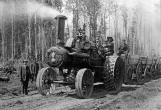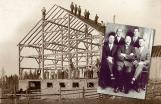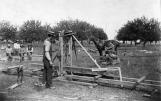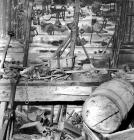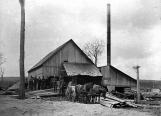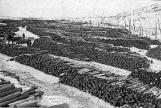1
The commercial timber trade in 1910 was focused on two major wood procedures; harvesting and processing. The latter comprised of sawing boards, planning them smooth and manufacturing wood products such as sashes and doors for house building. There were also custom orders for large timbers used in underground framing in mine tunnels or shafts.First trees were cut, hauled to a sawmill site and then cut into dimensional lumber, such as boards or planking, large squared timber for building structures and many other cut products. Second, the paper mills were huge consumers of wood, which was ground up into pulp to make paper. Hence, the ?pulpwood? trade was a major economic factor in Northern Ontario. Farmers throughout Temiskaming depended on work harvesting trees that would be cut into 8 ft. lengths. In this form they were shipped via railway to mills throughout the country and especially the U.S.
In lumbering, there were large and small operators. The farm-based or local operator could successfully work with a team and a few men to cut and haul timber to a landing at a river for example.
The photo composite of 1910 shows the most efficient method of hauling ? winter sleighs. The sawn boards were being hauled from the Shepherdson sawmill in Hudson Township. The next shows a few men wrestling a large cut tree in an area of the Blanche River. The bottom photo shows a ?Sweep? raft and pointer boat. This crew would collect and manage logs as they went down the Blanche River. The Blanche was a slow moving gentle river except farther upstream at a number of rapids, although in spring breakup, any of the rivers would have their own hazards for the men.
The demand for building materials was high by 1910. It was now generally more desirable to build a frame and board home rather than a log house, although many setters still built in this money-saving way. All the towns in the district were experiencing tremendous growth.
The mines of Cobalt and the new gold towns of Porcupine and Kirkland Lake added to the demand for sawn lumber. With a convenient railway at hand, the large and small contractors could fill supplies of lumber. Every township had numerous small-scale operations that used portable sawmills.
5
The Agricultural Society?s exhibit building1912
Dymond Township (Temiskaming Shores),District of Temiskaming, Ontario.
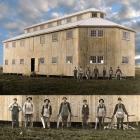
10
Lumber from Twin Lakes on the fringe of the agricultural areac1910
Hudson Township, District of Temiskaming
